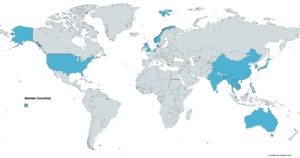Regional Cooperation Agreement on Combating Piracy and Armed Robbery against Ships in Asia facts for kids

Logo of the Regional Cooperation Agreement on Combating Piracy and Armed Robbery against Ships in Asia - Information Sharing Centre
|
|
| Abbreviation | ReCAAP ISC |
|---|---|
| Formation | 29 November 2006 |
| Type | International organization |
| Purpose | Anti Piracy |
| Headquarters | Singapore |
|
Area served
|
Asia |
|
Membership
|
21 Contracting Parties |
|
Executive Director
|
Krishnaswamy Natarajan |
The Regional Cooperation Agreement on Combating Piracy and Armed Robbery against Ships in Asia, known as ReCAAP, is an important agreement. It helps countries in Asia work together against piracy and armed robbery at sea. This agreement was first made in November 2004.
ReCAAP also includes the Information Sharing Centre (ISC). This center helps share important information about piracy. So far, 21 countries around the world have joined the ReCAAP agreement.
Contents
What is ReCAAP?
ReCAAP stands for the Regional Cooperation Agreement on Combating Piracy and Armed Robbery against Ships in Asia. It is the first agreement of its kind where governments work together. Their goal is to stop piracy and armed robbery against ships in Asian waters.
The idea for ReCAAP ISC came about in 1999. This was because many people were worried about piracy. The agreement officially started in November 2006. This happened after enough countries agreed to join.
Today, 21 countries are part of ReCAAP. These include 14 countries from Asia, 5 from Europe, Australia, and the USA.
Countries in ReCAAP
(As of August 2021)
How ReCAAP Works
ReCAAP is set up like a network to improve safety at sea. It has an Information Sharing Centre (ISC) and a Governing Council. The ISC is a place where information is shared. It connects with special contact points in each member country. This is done through an Information Network System (IFN).
The Governing Council has one person from each member country. Their job is to watch over the contact points. They also make sure the ISC follows its rules.
The Information Sharing Centre (ISC)
The ReCAAP Information Sharing Centre (ReCAAP ISC) was officially opened in Singapore on November 29, 2006. Krishnaswami Natrajan is currently in charge as the Executive Director.
The ISC helps reduce piracy and robbery at sea. It helps authorities understand and prevent these problems. It does this through three main ways:
- Sharing information about safety in the region.
- Helping countries improve their skills to fight piracy.
- Planning ways for countries to work together.
Sharing Information
The ReCAAP ISC shares quick and correct information about piracy and sea robbery. The ISC works 24/7 to share information with the contact points in member countries. This helps the ISC send warnings to ships. It also helps law enforcement agencies in coastal countries respond quickly.
The ISC collects and checks detailed information about incidents. Then, it provides accurate facts and analysis. This is done through regular reports, like weekly, monthly, and annual updates.
Information sharing includes:
- Creating a network to make communication easy between the ISC and contact points.
- Launching an IFN mobile app in 2014. This made it easier to report incidents.
- Publishing reports, warnings, and updates. They also hold meetings based on accurate reports from contact points.
Building Skills
The ReCAAP ISC helps member countries get better at reporting and sharing information. They do this by training people and sharing good ways of working. They also provide updates on piracy and armed robbery.
The ISC also helps contact points work with other government groups and shipping companies. The people on the Governing Council help guide these contact points. They also make sure the ISC's plans are followed.
Working Together
The ReCAAP ISC encourages cooperation with other groups. These include international organizations and shipping groups. They share information and good practices. This helps them work together to fight piracy and armed robbery.
The ISC has signed agreements with groups like the IMO and INTERPOL. They also work with shipping groups like BIMCO and INTERTANKO. Working together can include workshops. Here, members share their experiences and best ways to handle problems.
Understanding Incidents
ReCAAP's regular reports describe how serious incidents are and where they happen. They also look at specific cases to find patterns. These reports share good safety tips too.
The ISC looks at two main things to understand how serious an incident is:
- How much violence was used: This includes if weapons were used, how the crew was treated, and how many pirates were involved.
- The economic impact: This looks at what was stolen or damaged during the attack.
Based on these factors, ReCAAP ISC puts all incidents into one of four groups.
Types of Incidents
The four types of incidents are:
- CAT 1 (Most serious incidents): These involve more than 9 attackers. They are usually armed. The ship's crew might be hurt. The ship might be taken over, or its cargo stolen.
- CAT 2 – These involve about 4 to 9 attackers. They are often armed, and the crew might be threatened. Sometimes, the crew is hurt. The attackers might steal money or other items.
- CAT 3 – These involve about 1 to 6 attackers. They are sometimes armed. The crew usually does not get hurt. Often, the attackers cannot steal anything from the ship or its cargo.
- CAT 4 (Less serious incidents): These involve about 1 to 3 attackers. The attackers are not armed, and the crew is not harmed. The attackers usually leave without taking anything.
This way of grouping incidents helps ReCAAP ISC explain the piracy situation in Asia. It also helps ships and companies understand the risks.


